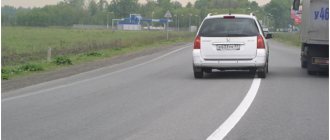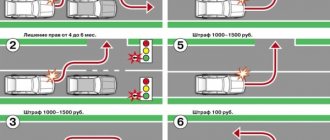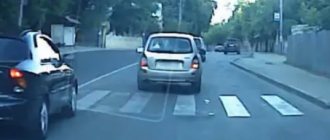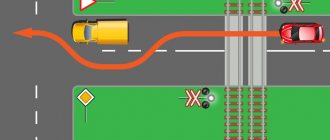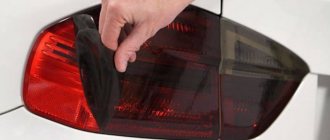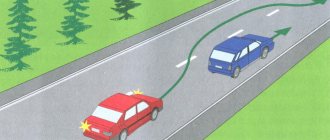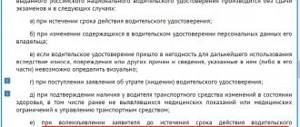Contradiction between traffic rules and administrative codes
According to the traffic rules established in 2021, standard overtaking consists of several basic manipulations.
This may involve driving into the oncoming lane, possibly getting ahead of one vehicle or several at once, and then returning to the lane that was previously occupied.
Many drivers are interested in the question of whether or not it is possible to carry out such a manipulation, how to cross a solid marking line when overtaking and avoid losing a driver’s license if a violation was detected by traffic police officers.
Clarification of the Supreme Court on the completion of overtaking
The position of the Supreme Court, which is given in paragraph 15 of the Resolution of June 25, 2019, is fully consistent with the above paragraph 9.11 of the Traffic Rules:
15. Actions of the driver associated with violation of the requirements of the Russian Federation Traffic Regulations, as well as road signs or markings, resulting in driving into a lane intended for oncoming traffic, or onto tram tracks in the opposite direction (except for cases of avoiding an obstacle (clause 1.2 of the Russian Traffic Regulations), which are qualified in part 3 of this article) are subject to qualification under Part 4 of Article 12.15 of the Code of Administrative Offenses of the Russian Federation.
Directly such requirements of the Russian Federation Traffic Regulations are established, in particular, in the following cases:
a) on any two-way roads, driving in a lane intended for oncoming traffic is prohibited if it is separated by tram tracks, a dividing strip, markings 1.1, 1.3 or markings 1.11, the broken line of which is located on the left (clause 9.11 of the Russian Traffic Regulations);
In this case, the actions of a person who entered the lane intended for oncoming traffic, in compliance with the requirements of the traffic rules of the Russian Federation, but who completed this maneuver in violation of these requirements, are also subject to qualification under Part 4 of Article 12.15 of the Code of Administrative Offenses of the Russian Federation.
That is, crossing a solid road at the end of overtaking falls under Part 4 of Article 12.15 of the Administrative Code.
Is it allowed to overtake through a solid road?
The modern automobile market is developing quite rapidly. Brand new models are constantly appearing, each of which is equipped in such a way as to fully satisfy the requirements of buyers - experienced drivers and beginners.
The number of buyers who have the opportunity to purchase a personal car is increasing almost every day. People are simply beginning to switch to their personal means of transportation en masse.
For each individual driver this is not a problem, but for the whole world as a whole, for city and country streets, such an abundance of cars becomes a problem, since the number of accidents increases significantly.
If we take into account the latest trends, based on which the driver has at least once had an accident while driving, the legislation is gradually changing to suit this or that time, traffic rules are becoming more stringent.
Despite this, it is quite difficult to avoid various violations. The reason for the occurrence of such difficult situations lies primarily in the gradual decrease in the usual space on the road.
There are a huge number of cars on the roads with drivers sitting in them, where everyone strives to get to their destination as quickly as possible.
It is difficult to find a motorist who would not find himself in a situation where he has to drive for a very long time, moving along the highway at a fairly slow speed.
The reason for such a slowdown is often based on the fact that there is a real caravan of loaded trucks ahead of the car. It is clear that when a good moment arises, most motorists try to avoid an obstacle in the form of a slow-moving vehicle. Very often in such situations, advance is carried out in violation of certain rules.
In the process of overtaking cars, drivers very often begin overtaking on intermittent markings and complete the maneuver on solid ones. This is a direct violation of currently valid traffic rules.
Most drivers are sure that such a violation of the rules is interpreted in the law not entirely correctly, while current legislative standards stubbornly insist that crossing a solid line in the process of overtaking is a direct violation of traffic rules.
For such manipulations, a fine may be imposed for crossing a solid line when completing overtaking in 2021 . Depending on the situation, the driver may be subject to a monetary fine, as well as temporary deprivation of his driver's license.
No driver wants to lose his license, so it’s worth familiarizing yourself with the rules for such overtaking. You can learn how to get ahead of the curve and at the same time not violate the current traffic rules.
It is worth noting that nominally manipulations of this kind are both prohibited and permitted . The assessment of the situation in this case will depend on the traffic police officers, on the level of their responsibility and conscientiousness.
Features and conditions for completing overtaking
At its core, overtaking across a continuous road is one of the most serious violations . It is impossible to avoid punishment for this. On modern roads, GOST is valid regarding the features and rules for marking.
If these white lines were drawn without taking into account certain legal requirements, it will not be easy to prove your innocence.
In other words, the answer to the question whether overtaking on a continuous road is a violation will be positive.
According to traffic rules, before a solid dividing line appears on the highway, additional warning markings must be applied. We are talking about standard markings, which look like small white rectangular lines.
The distance between them is allowed to be quite large. As soon as the marking changes in appearance, that is, the lines become approximately three times longer than the usual short ones, and the distance between them becomes less and less.
In this section, overtaking will be quite difficult, fraught with certain penalties and emergency situations. The illegality of such an action is based on the fact that in the process of completing overtaking you can accidentally slow down and move to a continuous line.
According to GOST requirements, it is strictly forbidden to apply a continuous standard line immediately after a broken one . Between these categories of lines there must be special intermediate signs.
Based on them, the driver must understand that after some time there will be a continuous line of markings on the road, and accordingly, overtaking is strongly not recommended.
If, during a difficult or emergency situation, the driver is sure that the markings on the highway are applied incorrectly, this must be indicated to traffic police officers . This will help you maintain your driver’s license and not face any punishment.
Solid and overtaking according to traffic rules
One of the most popular maneuvers on the highway is overtaking. This is driving into the oncoming lane to get ahead of the vehicle in front, and driving back to your part of the road. Using this technique, you can greatly speed up your travel time, but at the same time it is dangerous. Therefore, you need to overtake other cars on the road carefully, and the driver must be careful - a head-on collision can be fatal.
Car owners, especially beginners, initially confuse the concepts of “overtaking” and “advancing.” According to traffic rules, three aspects distinguish the first from the second:
- during the maneuver, the car moves to the left, entering the oncoming lane;
- advance of the vehicle moving ahead;
- returning to your lane, while the overtaken vehicle remains behind.
Sometimes when performing such a trick, you have to drive out of the continuous lane, which is a serious violation. It can be single or double. The first is used in many cases, in particular, to separate oncoming flows. And a double one is necessary to separate oncoming lanes with at least 4 lanes in both directions.
Penalties in 2021
The decision of the Supreme Court, in the process of legally deciding the question of whether it is possible to cross a solid line when overtaking, decided to classify such a process as a serious offense.
According to modern legislation, violation of such a rule must necessarily be punished. However, at the same time, the law regulated the possibility of effectively preventing, if not a dangerous situation, but the resulting liability.
A fine and deprivation of a driver's license can be successfully avoided if you prove the inattention of employees of modern road services who made a mistake in the process of applying markings on the highway.
Violations of this type fall under the category of cases of certain administrative liability. In full accordance with the rules of the Code of Administrative Offenses of Russia, the legal punishment for the violator may be a certain financial penalty or confiscation of the driver’s license.
It should be noted that the penalty is chosen strictly by the traffic police, who in most cases prefer to deprive the driver of his license rather than impose a fine.
The amount of the penalty in 2021 may reach 5,000 rubles, while back in 2015 the fine amount was only 1,500 rubles . In other words, there has been a significant increase in the amount, which is based on the rapid increase in the number of emergency situations.
Many road accidents when crossing a solid line lead to the most unforeseen and tragic consequences.
Very often, seemingly innocent overtaking of a car across a solid line becomes the cause of very serious accidents directly involving several vehicles at the same time.
Speaking about the terms of withdrawal of rights, they range from 4 to 6 months. The exact sentence to be awarded depends on the degree of guilt of the driver.
If during the process of violation the driver causes additional risks for other drivers, the person will be deprived of his license for a period of six months. If there are no serious consequences, the deprivation of rights will be 4 months.
Challenging violations and penalties
In certain situations, a driver has the right to challenge a violation while overtaking vehicles on a highway.
If the overtaking process was started on a broken line and completed on a solid line, this will be considered a fairly serious violation, which may result in a serious penalty.
It is possible to challenge the situation and thereby avoid possible liability for violating traffic rules and overtaking in only one situation.
This applies to the case when employees of public utilities and road services made certain mistakes in the process of marking the highway.
This is a serious shortcoming of road company employees, who are punished for the reason that road users are automatically placed in a risky position by means of such markings.
If the road markings were applied in accordance with established rules, it will be impossible to prevent punishment . The violator is guaranteed to pay a fine, and in more complex and dangerous situations will be deprived of his driver's license.
The exact punishment will be based on the severity of the violation and what consequences it caused.
Completing overtaking through a solid line
15. Actions of the driver associated with violation of the requirements of the Russian Federation Traffic Regulations, as well as road signs or markings, resulting in driving into a lane intended for oncoming traffic, or onto tram tracks in the opposite direction (except for cases of avoiding an obstacle (clause 1.2 of the Russian Traffic Regulations), which are qualified under part 3 of this article), are subject to qualification under part 4 of article 12.15 of the Code of Administrative Offenses of the Russian Federation.
Directly such requirements of the Russian Federation Traffic Regulations are established, in particular, in the following cases: a) on any two-way roads, driving in a lane intended for oncoming traffic is prohibited if it is separated by tram tracks, a dividing strip, markings 1.1, 1.3 or markings 1.11, intermittent the line of which is located on the left (clause 9.1(1) of the Russian Traffic Regulations);
b) on two-way roads with four or more lanes, it is prohibited to drive into the lane intended for oncoming traffic to overtake or bypass (clause 9.2 of the Russian Traffic Regulations);
c) on two-way roads with three lanes marked with markings, the middle of which is used for traffic in both directions, it is prohibited to drive into the leftmost lane intended for oncoming traffic (clause 9.3 of the Russian Traffic Regulations);
d) it is not allowed to overtake a vehicle moving in front that is overtaking or avoiding an obstacle, or moving ahead in the same lane and signaling a left turn, as well as a vehicle following behind that has begun overtaking; The overtaking maneuver is also prohibited if, upon completion, the driver cannot, without creating a danger to the movement or interference with the overtaken vehicle, return to the previously occupied lane (clause 11.2 of the Russian Traffic Regulations);
e) overtaking is prohibited at signalized intersections, as well as at uncontrolled intersections when driving on a road that is not the main one; at pedestrian crossings; at railway crossings and closer than a hundred meters in front of them; on bridges, overpasses, overpasses and under them, as well as in tunnels; at the end of the climb, at dangerous turns and in other areas with limited visibility (clause 11.4 of the Russian Traffic Regulations);
f) it is prohibited to drive around vehicles standing in front of a railway crossing into oncoming traffic (paragraph eight of clause 15.3 of the Traffic Regulations of the Russian Federation);
g) it is prohibited to drive onto tram tracks in the opposite direction (clause 9.6 of the Russian Traffic Regulations);
h) the turn must be carried out in such a way that when leaving the intersection of roadways the vehicle does not end up on the side of oncoming traffic (clause 8.6 of the Russian Traffic Regulations).
In addition, by virtue of clause 3.2 of the Traffic Regulations of the Russian Federation, it is prohibited to overtake a vehicle that has special color schemes applied to the outer surfaces, with a blue flashing light and a special sound signal turned on, or a vehicle that has special color graphics applied to the outer surfaces, with the flashing lights turned on. blue and red colors and a special sound signal, as well as the vehicle(s) accompanying it (for example, an organized transport convoy).
Driving on a two-way road in violation of the requirements of road signs 3.20 “Overtaking is prohibited”, 3.22 “Overtaking by trucks is prohibited”, 5.11.1 “Road with a lane for fixed-route vehicles”, 5.11.2 “Road with a lane for cyclists”, 5.15 .7 “Direction of traffic along the lanes”, when it is associated with entering the lane of oncoming traffic, and (or) road markings 1.1, 1.3, 1.11 (separating traffic flows in opposite directions) also forms the objective side of the administrative offense provided for in Part 4 of Article 12.15 Code of Administrative Offenses of the Russian Federation. Failure to comply with the requirements of road signs 4.3 “Roundabout”, 3.1 “Entry prohibited” (including signs 8.14 “Traffic lane”), as a result of which the vehicle entered the lane intended for oncoming traffic, can also be qualified according to this standard.
In this case, the actions of a person who entered the lane intended for oncoming traffic, in compliance with the requirements of the traffic rules of the Russian Federation, but who completed this maneuver in violation of these requirements, are also subject to qualification under Part 4 of Article 12.15 of the Code of Administrative Offenses of the Russian Federation.
In the event that the objective side of the administrative offense provided for in Part 4 of Article 12.15 of the Code of Administrative Offenses of the Russian Federation is expressed in entering the lane intended for oncoming traffic in violation of the requirements of a road sign or road markings, when considering the case it is necessary to keep in mind that such a sign /markings (including temporary ones) must/must be installed/painted in accordance with the legislation of the Russian Federation and recorded/fixed on the road traffic management scheme (project) (including temporary ones).
It is also necessary to keep in mind that overtaking slow-moving vehicles cannot be qualified under Part 4 of Article 12.15 of the Code of Administrative Offenses of the Russian Federation in cases where the driver, within the coverage area of road sign 3.20, overtook a vehicle for which the manufacturer set a maximum speed of no more than thirty kilometers per hour, including in the absence of an identification sign on it informing road users that this vehicle belongs to low-speed vehicles. In this case, the driver performed a maneuver in accordance with the requirements of the specified road sign, and therefore he cannot be held administratively liable for the inaction of the owner (owner) of a slow-moving vehicle who did not install the appropriate identification sign on this vehicle in violation of the requirements of paragraph 8 Basic provisions.
At the same time, the actions of a driver who, in the coverage area of sign 3.20, overtook a mechanical vehicle moving at a speed of no more than thirty kilometers per hour, but which, by its design features, is not a low-speed vehicle, are subject to qualification under Part 4 of Article 12.15 of the Code of Administrative Offenses of the Russian Federation.
What to do if a violation is detected?
If a driver is stopped and charged with a violation for crossing a solid median, and if he is confident of his innocence, it is important to take certain actions.
While the traffic police officer is busy with paperwork, it is worth studying and recording the general road situation. It is advisable to immediately photograph the emergency situation using your phone. This will be quite enough.
The resulting photo must include the following objects:
- route;
- signs;
- markings;
- automobile.
During the process of drawing up the protocol, you do not need to indicate your agreement with the violation, you do not need to register the fact of driving onto a continuous marking and how long it took to move along the oncoming lane.
It is enough to simply reflect all the measurements taken and indicate that a photograph is attached to the protocol.
During the conversation with the inspector, it is worth drawing his attention to the fact that it was not the rules of permissible advance that were violated, but the position of the car. It is wrong to advance and to overtake - these are two different things .
If there are any contradictions or disagreements with a traffic police officer, you should definitely record your disagreement in the protocol. It is imperative to require the inspector to draw up this document, the most detailed diagram of the violation.
It would not be out of place to mention that all the actions of the inspector and his reluctance to resolve the situation will be appealed in court.
Summing up
The driver will be guilty of committing a traffic violation if traffic police officers determine that he had the opportunity to comply with all the standards and rules established by law, but he did not take all the necessary measures to carefully comply with them.
Penalties will most likely be canceled if the driver would have to use even more dangerous emergency braking or suddenly wedge into a nearby column of vehicles to return to the designated lane.
Video: Started overtaking on intermittent - ended on continuous
What is the penalty for overtaking on a continuous road?
According to the law, there is no difference between a driver who finished overtaking on the continuous road and one who continued driving on the oncoming lane. However, upon detailed investigation with the involvement of lawyers, it turns out that everything depends on the specific situation.
The punishment for driving into the oncoming lane, according to part 4 of Article 12.15 of the Administrative Code, is a fine of 5,000 rubles and deprivation of a driver’s license for a period of 4-6 months. Similar sanctions are faced by a driver who starts overtaking on an intermittent and ends on a continuous one. However, if you can prove the actual impossibility of completing the started maneuver on time, you can limit yourself to only a fine, without deprivation of your driver's license.
Every driver knows that before the start of a solid line, the broken markings “lengthen”. Accordingly, the beginning of a continuous one cannot come as a surprise. However, if you can prove in court that there was no way to complete overtaking on a broken marking line due to certain circumstances, then you can count on a positive outcome of the proceedings for you . All that is needed for this is to collect irrefutable evidence in the case (testimony of the person being overtaken and witnesses, layout diagrams, and so on).

